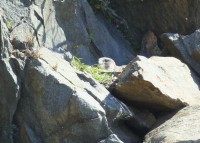Peregrine Falcons: copulating in Woburn!
March 18, 2018 in Peregrine Falcon Woburn, Peregrine Falcons Eastern Massachusetts, Peregrine Falcons Massachusetts
 Made a short stop to observe the Peregrine Falcons in Woburn this morning. Upon arrival, stopped initially at quite a distance to focus binoculars on the female. She was perched on an upper ledge well to the west of the nest ledge. Moments later, from out of sight, the male launched into a big swooping dive and then moved up towards the female. He approached her from the air and landed on her back with clenching his talons in a ball and resting on his tarsi.
Made a short stop to observe the Peregrine Falcons in Woburn this morning. Upon arrival, stopped initially at quite a distance to focus binoculars on the female. She was perched on an upper ledge well to the west of the nest ledge. Moments later, from out of sight, the male launched into a big swooping dive and then moved up towards the female. He approached her from the air and landed on her back with clenching his talons in a ball and resting on his tarsi.
Typically, as the male prepares to mount, the female sleeks feathers, crouches, and leans forward, and may move her tail up and to side. During copulation, the female is normally at an angle of about 45° with wings slightly lifted and extended (from elbow), sometimes tail partly spread. The male makes every effort to maintain an upright position throughout copulation by flapping wings high above body and balancing on his tarsi with closed toes and feet turned inward. During copulation, the male’s neck is extended and curved; he chitters while she gives copulatory wail.
After close to ten seconds, the male departed and landed in the nest ledge and the female remained in place.
Reference cited:
White, Clayton M., Nancy J. Clum, Tom J. Cade and W. Grainger Hunt. 2002. Peregrine Falcon (Falco peregrinus), version 2.0. In The Birds of North America (P. G. Rodewald, editor). Cornell Lab of Ornithology, Ithaca, New York, USA. https://doi.org/10.2173/bna.660



